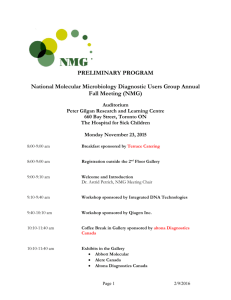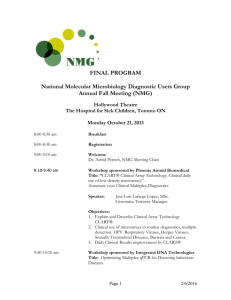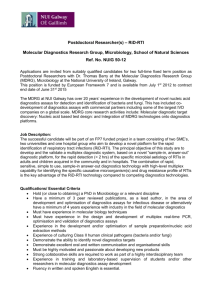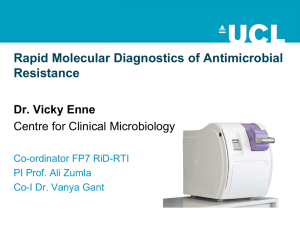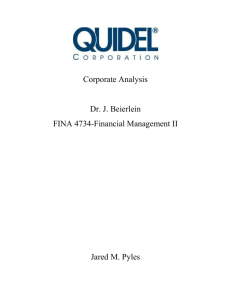final program
advertisement
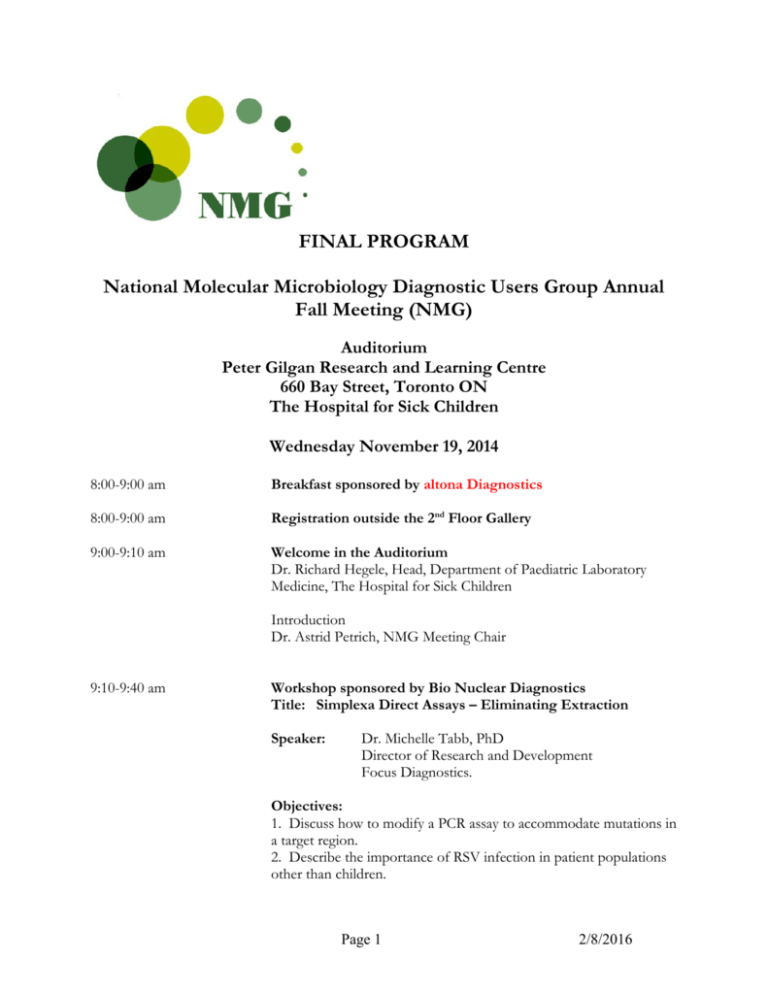
FINAL PROGRAM National Molecular Microbiology Diagnostic Users Group Annual Fall Meeting (NMG) Auditorium Peter Gilgan Research and Learning Centre 660 Bay Street, Toronto ON The Hospital for Sick Children Wednesday November 19, 2014 8:00-9:00 am Breakfast sponsored by altona Diagnostics 8:00-9:00 am Registration outside the 2nd Floor Gallery 9:00-9:10 am Welcome in the Auditorium Dr. Richard Hegele, Head, Department of Paediatric Laboratory Medicine, The Hospital for Sick Children Introduction Dr. Astrid Petrich, NMG Meeting Chair 9:10-9:40 am Workshop sponsored by Bio Nuclear Diagnostics Title: Simplexa Direct Assays – Eliminating Extraction Speaker: Dr. Michelle Tabb, PhD Director of Research and Development Focus Diagnostics. Objectives: 1. Discuss how to modify a PCR assay to accommodate mutations in a target region. 2. Describe the importance of RSV infection in patient populations other than children. Page 1 2/8/2016 3. Discuss the importance of a moderate complexity test for detecting HSV in CSF in light of the challenge to differentiate other causes of infection in neonates. 9:40-10:40 am Workshop sponsored by bioMérieux Canada Inc. Title: FilmArray technology – Why A Molecular Syndromic Panel? Speaker: Beth Amiott, Associate Director Regulated Products BioFire Diagnostics, LLC Objectives: 1. Discuss the current medical context and the clinical difficulties encountered by the clinicians and the importance of an accurate diagnosis. 2. Review of the integrated technology used by the FilmArray 3. FilmArray publications review for Respiratory, GI and BCID and discussion 10:40-11:10 am Coffee Break in Gallery sponsored by Phoenix Airmid biomedical 10:40-11:10 am Exhibits in the Gallery Abbott Molecular Alere Canada BD bioMérieux Canada Inc Bio Nuclear Diagnostics Cedarlane Hologic Canada Illumina Integrated DNA Technologies Inter Medico Luminex Phoenix Airmid Biomedical Pro-Lab Diagnostics Promega Corp. Qiagen Quidel Corp./Life Technologies Roche Diagnostics Somagen Diagnostics Inc Zeptometrix Page 2 2/8/2016 11:10-11:40 pm Workshop sponsored by Integrated DNA Technologies Title: Techniques for Improved Detection of Rare Targets in Biological Samples Speaker: Nick Downey, PhD Scientific Application Specialist Integrated DNA Technologies Objectives: 1. Discuss the difficulties in detecting rare DNA sequences using molecular diagnostic methods including NGS. 2. Describe two methods that improve detection of rare DNA targets: IDT xGen Lockdown Probes for capturing specific targets and RNase H–dependent PCR technology for sensitive, singlenucleotide discrimination of amplification products 11:40-12:10 pm Workshop sponsored by Illumina Title: Sequencing in Microbiology and Infectious Disease: What’s Available Today? Speaker: Michael G Smith, PhD. Sr. Sequencing Specialist, Illumina Objectives: 1. Introduce Next Generation Sequencing and Illumina 2. Provide an overview of clinical microbial applications 3. Discuss potential analysis methodologies 12:10-1:00 pm Lunch in the Gallery sponsored by Zeptometrix 1:00-2:00 pm Workshop sponsored by BD Title: New Technologies for Detection of Enteric Pathogens Algorithms, Applications, and Advantages of Molecular Diagnostics Speaker: Blake W. Buchan, PhD, D(ABMM) Assistant Professor of Pathology, Medical College of Wisconsin Associate Director, Clinical Microbiology Dynacare Laboratory Page 3 2/8/2016 Objectives: 1. Identify 2 advantages of molecular assays compared to culture for identification of enteric pathogens 2. Discuss the strengths and weakness of large, highly multiplex panels 3. Recognize the relative cost and value of molecular diagnosis of enteritis to the patient and laboratory 2:00-2:30 pm Workshop sponsored by altona Diagnostics Title: Laboratory Workflow and the Efficiency of Automation Speaker: Markus Hess, PhD Chief Scientific Officer altona Diagnostics GmbH Hamburg, Germany Objectives: 1. Examine the PCR parameters that can be modified to improve efficiency: liquid handling, DNA/RNA extraction and thermal cycling 2. Discuss how the RealStar Solution achieves “Extraction to Detection” in 3.5hrs 2:30-3:00 pm Coffee Break in the Gallery 2:30-3:00 pm Exhibits in the Gallery 3:00-4:00 pm Workshop sponsored by Hologic Canada Title: Performance Characteristics of Automated Instruments and Second Generation Molecular Assays for the Diagnosis of Sexually Transmitted Infections. Speakers: Sam Ratnam PhD, Clinical Professor, Memorial Univ, St John’s, NL; Adjunct Professor, McGill Univ, Montreal, QC Max Chernesky Phd, Prof. emeritus, McMaster Univeristy, Hamilton, ON Objectives: 1. To compare sensitivity and specificity of four second generation NAATs to detect CT and NG from female urine and self-collected vaginal swabs. Page 4 2/8/2016 2. To compare hands on time, time to results, maintenance and consumables on five automated instruments when testing urines and vaginal swabs by running 96 and 192 tests. 4:00-4:30 pm Workshop sponsored by Quidel and Life Technologies Title: Comparison of Quidel Lyra Influenza A+B and RSV+ hMPV to the Altona RealStar Influenza and RSV RT-PCR assays on the Applied Biosystems 7500 Fast Dx PCR System in a high volume laboratory setting Speaker: Tony Mazzulli, MD, FRCPC, FACP Microbiologist-in-Chief Department of Microbiology Mount Sinai Hospital Toronto, ON Objectives: 1. Discussion of the respiratory viruses of primary concern and benefits of multiplex assays for these viruses 2. Performance comparison of Quidel Lyra respiratory assays with Altona and Focus Diagnostics 3. Benefits and workflow of the Quidel Lyra Flu A+B and RSV+ hMPV assays and experiences at Mount Sinai Hospital in their patient population 4:30-5:00 pm Workshop sponsored by Quidel and Life Technologies Title: Detection of HSV in Skin and Genital Lesions: Comparison of Culture vs AmpliVue® HSV 1+2 Speaker: Christian Renaud MD MSc FRCPC Medical Microbiologist & Pediatric Infectious Diseases Virology Laboratory Medical Director CHU Sainte-Justine Montréal, QC Objectives: 1. Importance of detecting genital herpes during pregnancy and prevention of neonatal infections 2. Performance and workflow compared to culture and an in-house PCR assay 3. Validation and implementation of a molecular HSV assay in the clinical microbiology laboratory Page 5 2/8/2016 Peter Gilgan Research and Learning Centre The Hospital for Sick Children, Toronto ON Thursday November 20, 2014 8:00-9:00 am Breakfast in the Gallery sponsored by Luminex Corp. 8:00-9:00 am Exhibits in the Gallery 9:00-9:45 am LiDS: Listeria detection and surveillance using Next Generation Sequencing Tools Speaker: Chrystal Berry, PhD Biologist, Public Health Genomics Unit National Microbiology Laboratory Objectives: 1. Large-scale comparative genomic analysis of a diverse panel of Listeria monocytogenes strains from human- clinical cases, food products and the food processing environment 2. The identification of new Listeria monocytogenes genetic markers for incorporation into a rapid high-throughput detection assay that can be deployed within the food processing environment 3. The development and validation of rapid LAMP and RT-PCR assays for Listeria detection and discrimination into pathogenic and non-pathogenic subtypes. 9:45-10:30 am Direct Detection of Pathogens in Patient Specimens by 16S rDNA PCR: Perspectives from Three Laboratories. Speakers: Kathryn Bernard Head, Special Bacteriology National Microbiology Laboratory Page 6 2/8/2016 Sara Christianson Biologist, National Reference Centre for Mycobacteriology. National Microbiology Laboratory Julianne Kus Clinical Microbiologist Public Health Ontario Objectives: 1. Advantages of testing directly from patient specimens by 16S rRNA gene and other targets 2. Technical issues and challenges associated with successful PCR and sequencing directly from patient specimens 3. Summarize results obtained when detection of pathogen was successful. 10:30-11:00 am Coffee Break and Exhibits 11:00-11:45 am Digital PCR - Refining Traditional PCR and its Application to Development of an HIV-2 Quantitative RNA Assay Speaker: John Kim Chief of National Laboratory HIV Reference Services Objectives: 1. Brief introduction to dPCR and how it differs from traditional PCR (including advantages of dPCR). 2. NLHRS development of an in-house HIV-2 quant (RNA) assay using d-PCR. 3. Future applications. 11:45-12:15 pm Mathematical Microbiologists: Why we need to return to our square roots to uncover uncertainty (of measurement) in qPCR Speakers: James Stuart MD George Zahariadis MD Clinical correlates from Marina Salvadori MD Objectives: 1. Identify why uncertainty of measurement is required for qPCR and how it is important clinically. Page 7 2/8/2016 2. Outline why you may be understating your uncertainty if don't account for ratios and why a "black box" approach is not always appropriate.. 3. Present methods for UOM for qPCR (Box, Delta, Fieller, Bootstrap) 4. Present for discussion: a) The need for universal standards, b) How actual patient samples may be advantageous in UOM 12:15-1:30 pm Lunch in the Gallery 12:30 1:30 pm NMG AGM (All participants are invited to attend) Auditorium 1:30-2:00 pm Results of the 2014 National Proficiency Test for 16SrRNA Gene Sequencing and/ or MALDI-TOF Speaker: Kathryn Bernard Head, Special Bacteriology National Microbiology Laboratory Objectives: 1. Describe need for an external proficiency test for 16S rRNA gene sequencing and MALDI-TOF instrumentation 2. Describe 4 bacteria selected for the panel associated with different degrees of complexity for accurate identification 3. Present results by 35 participant laboratories for each of the 4 test bacteria, striated down by method; nuances regarding use of both identification method will be reviewed. 4. Discuss next steps for proficiency testing 2:00-3:30 pm Trouble-shooting/Interesting Cases Chair: 3:30 pm Linda Chui, PhD, ARMCCM Alberta Provincial Laboratory Edmonton, AB Official Close of Meeting The NMG would like to thank all of our Industry Sponsors and acknowledge a generous Educational Grant towards the meeting from CACMID. Page 8 2/8/2016
